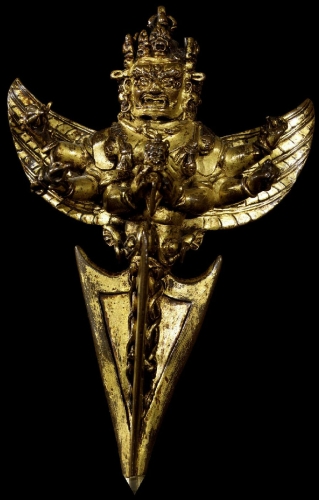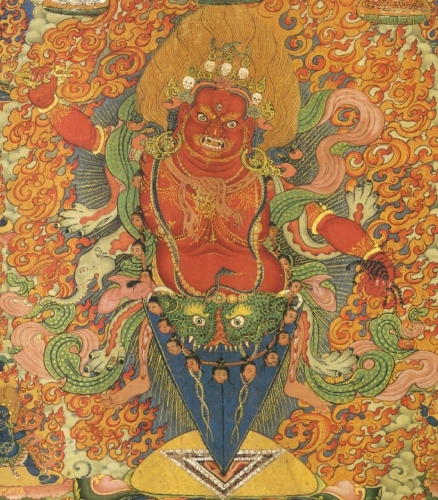Buddhist practice and Buddhist art have been inseparable in the Himalayas ever since Buddhism arrived to the region in the eighth century. But for the casual observer it can be difficult to make sense of the complex iconography. Not to worry—Himalayan art scholar Jeff Watt is here to help. In this “Himalayan Buddhist Art 101” series, Jeff is making sense of this rich artistic tradition by presenting weekly images from the Himalayan Art Resources archives and explaining their roles in the Buddhist tradition.
This week Jeff explains the significance of purba, a ritual implement and corresponding deity.
Himalayan Art 101: Purba
 Tibetan Buddhism can be described as a busy religion. There is always a lot going on and there are always things to do, remember, and learn. The learning curve can be very steep due to all of the jargon and special terminology. One example of this is the Tibetan word “purba” (also spelled “purpa”). This word comes up a lot, so what does it mean and to what does it refer?
Tibetan Buddhism can be described as a busy religion. There is always a lot going on and there are always things to do, remember, and learn. The learning curve can be very steep due to all of the jargon and special terminology. One example of this is the Tibetan word “purba” (also spelled “purpa”). This word comes up a lot, so what does it mean and to what does it refer?
Simply put, purba is a translation of the Sanskrit word “kīla,” which refers to a peg. Yes, a simple peg or stake—depending on which English speaking country you are from—such as a tent peg. Its function is to stake or peg things in place. It is not a dagger designed to be thrust, pulled out, and then thrust again. A purba is designed to hold something in place, remaining embedded in the ground or ritual surface.
 A purba generally has an elongated body measuring a few inches, though in some cases it can measure up to a foot. The bottom portion has three blades that taper to a point at the business end. It is a ritual object used in the creation of complex mandalas and in consecration rituals of all kinds. Styles of purba objects are myriad, with all kinds of animal heads decorating the top (a buffalo head is shown in the example here).
A purba generally has an elongated body measuring a few inches, though in some cases it can measure up to a foot. The bottom portion has three blades that taper to a point at the business end. It is a ritual object used in the creation of complex mandalas and in consecration rituals of all kinds. Styles of purba objects are myriad, with all kinds of animal heads decorating the top (a buffalo head is shown in the example here).
A purba, as described in early Buddhist tantric literature, has two modes of existence in rituals: imagined existence and physical existence. With regard to the physical existence, purba may be fashioned from wood, stone, metal, or any number of materials. In the Tibetan tradition a purba is usually made from metal or wood. Tibetan purba fashioned from iron-nickel meteorite fallen from the skies is highly prized.
According to early Indian tantric texts, a purba is a ritual object. Purba, however, is also the name of a popular Tibetan tantric deity (Dorje Purba, Vajrakīla) who originated in the Nyingma tradition of Tibetan Buddhism. This deity often appears with three faces, six hands, wings, a consort, and with the lower half of his body in the form of a purba, in lieu of legs. One of his hands clasps a small purba with three blades, a decorative handle, and three wrathful faces at the top representing the three faces of the deity himself. Such purbas are manufactured in great numbers, usually from metal, as a required personal object for practitioners of the purba ritual cycle and meditation practices. Sometimes very small purba made from gold or silver are worn around the neck in special metal amulets or textile-wrapped charms.

There exist a number of variant iconographic forms of the deity Dorje Purba. One very popular meditation practice focusing on the early teacher Padmasambhava depicts him in a wrathful form with one face, two arms, and the lower half of the body in the shape of a purba. Thus, in addition to being an important Nyingma meditational deity, Purba is also expressed in the lower body form of many other deities.
Learn more about purba from Himalayan Art Resources here.
See the buffalo headed purba in high-resolution here.
And the Vajrakīla mandala retinue figure here.
For Guru Drapur, click here.
And to see more deities with a “Kīla” lower body, click here.
Thank you for subscribing to Tricycle! As a nonprofit, we depend on readers like you to keep Buddhist teachings and practices widely available.